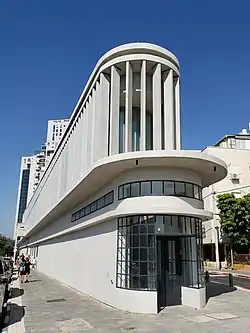Ramat Gan Museum of Israeli Art
The Ramat Gan Museum of Israeli Art is an art museum that displays Israeli art,[2] located on Abba Hillel Street of Ramat Gan, Israel. The museum was opened on 4 April 1987.
 | |
| Established | 1987 |
|---|---|
| Location | Abba Hillel Road 146, Ramat Gan, Tel Aviv District, Israel |
| Coordinates | 32.094589°N 34.819306°E |
| Type | Art museum |
| Visitors | 23,000 (2012)[1] |
| Director | Ran Gwetta |
| Website | rgma |
History
The building was built in the 1930s with the initial purpose of serving as an industrial plant. Prior to the opening of the museum, the building was converted into a museum space by architect Danny Schwarz, in order to serve its new purpose. In 2012, the museum had 23,000 visitors.[1] The museum was closed for renovation in 2017 and reopened in 2021.[3]
The museum has been showcasing eclectical exhibitions since the day of its opening. The current director is curator Meir Aharonson.[1] Of the museum's most popular and prominent exhibitions, we can find photographer Simha Shimran's photography exhibition, curator Yehudit Mezkel's motherhood themed group exhibition, and more. As of 2022, the exhibitions include paintings, photographs, video, installation art and sculpture.[3]
The museum found itself in the centre of controversy in 2021 when a painting which was deemed offensive to Haredi community was removed at the request of the mayor of Ramat Gan. Other artists whose works were displayed in the museum demanded that the museum remove their artworks, thus almost emptying the museum.[2]

See also
References
- Littman, Shani (September 9, 2014). "איך נהפך מוזיאון רמת גן מהבטחה גדולה להחמצה ענקית" [How did the Ramat Gan Museum turn from a big promise to a huge miss]. הארץ (in Hebrew). Haaretz Publishing Ltd. Retrieved 2022-01-14.
- "Artists feud with Ramat Gan museum over painting removed for slur against Haredim". Times of Israel. 2 January 2022. Retrieved 2022-01-14.
- "על המוזיאון". מוזיאון רמת גן לאמנות ישראלית (in Hebrew). Retrieved 18 April 2022.